Linear Parks as Urban Commons—Considerations from Mexico City
Abstract
:1. Introduction
- −
- How do the different uses of the “linear park” respond to the needs and perspectives of the diverse users and stakeholders involved in its development, use, and management, beyond an explicit policy agenda?
- −
- In what ways does the linear park represent a “common” space that presents appropriation and provision challenges in its various sections? How do the users in different sections collectively act to address these challenges, and what are the outcomes of these efforts?
- −
- To what extent do the interventions in the different sections of the linear park result from the collective action and agency of its users and actors, and how do they interrelate with political actors and local governments?
- The diverse uses of the sections of the linear park reflect the different needs and cultures of their uses, beyond the officially designated purpose. These also reflect processes of gentrification and disposition resulting from profound asymmetric power relations and elite capture.
- The collective action of the users of the park has different levels of success in addressing the main challenges faced in the maintenance of the space, from relatively high participation and maintenance in some areas of the sections, to abandon and decay in others.
- The collective action of the users of the park enables them to influence local policy and investment according to their needs, cultures, and priorities.
2. Materials and Methods
2.1. Methodology
2.2. Research Design
2.3. Research Process
- (A)
- The participant observation reconnaissance rides were conducted throughout the period 2017–2018 and included general observation sessions with which we sought knowledge of the conditions of the environment and the quality of the infrastructure present in the linear park. For each of the four sections of the selected bikeway, eight tours were conducted, as well as open interviews with different users.
- (B)
- In 2019, 59 semi-structured interviews were conducted to learn about local histories, the perception of users, the ways in which they experience the bikeway, security, and connections with the areas crossed, and recreational uses. These interviews made it possible to find correspondence between geostatistical data on living conditions and the perception of the users, identifying the areas with the highest levels of degradation, and those with unsecure conditions that posed risks, even for the development of the research. In the selection of the interviewees, we sought to interview people from each of the 4 sections, including users of different genders, age groups, socioeconomic sectors and relationships with the territory. The interviews conducted as follows: 13 in the Miguel Hidalgo track; 16 in the Álvaro Obregón track; 17 in the Magdalena Contreras track; 12 in the Tlalpan track.
- (C)
- In order to strengthen the information, a systematic record of the tours was made, in which 16 photographic sequences of the 4 sections of the bicycle path were recorded. A modification of SOPARC (System for Observing Play and Recreation in Communities) was used to count users and characterize them. The SOPARC system is based on momentary time sampling techniques in which systematic and periodic scans of individuals and contextual factors are conducted within predetermined target areas in community recreation settings. The system also includes linear parks in its protocol dictionary [53,54,55]. Photographic sequences were taken by a digital camera programmed to take photographs every three seconds, installed on a bicycle whose speed was maintained at 15 km/h (or 4.2 m/s) to generate a photograph every 12.6 m. Three photographs were established as the unit of analysis, to obtain a deep field of view of 37.8 m for the count. To capture the variety of situations, uses and users of the linear park, a tour was carried out simultaneously by 4 trained people, 1 for each section in both directions, at 8 a.m. in the North–South direction, 8:30 a.m. in the South–North direction, 3 p.m. in the North–South direction and 3:30 p.m. South–North. The rides were conducted on Mondays, Wednesdays, Fridays, Saturdays and Sundays in January and February 2020. The scanning of the units of analysis was performed by systematically and repeatedly observing, from left to right, the presence of users in the visual units of analysis recorded. We examined the utilization patterns and leisure activities associated with a bikeway, integrating observational techniques with quantitative annotations. We categorized users based on age (adults and juveniles) and gender (males and females), and documented the recreational activities such as jogging, standing, pedestrian endeavors, walking with pets, and cycling. Supplementing the quantitative data, we employed generalized, qualitative observational techniques to provide a deeper understanding of the diverse activities along the bikeway. These observations captured the broader context and motivations of individuals interacting with the bikeway. By merging the quantitative notation of users with qualitative observations, we sought to fully comprehend the various aspects of bikeway utilization. This integration of the demographic dispersion of users and the prevalence of specific recreational activities provided a nuanced analysis of the bikeway’s impact on diverse user groups.
2.4. Limitations
3. Results
3.1. Characterization of Sections
- −
- “Miguel Hidalgo” section: from Boulevard Manuel Ávila Camacho to Fernando Alencastre Street (Figure 4a).
- −
- “Álvaro Obregón” section: from Cabrio Street to Don Manuelito Street (Figure 4b).
- −
- “Magdalena Contreras” section: from Querétaro Street to Francisco del Olmo Street (Figure 4c).
- −
- The “Tlalpan” section: from Tetiz Avenue to Lirios Street (Figure 4d).
3.2. Actors
3.3. Uses, Exclusion, Rivalry, Appropriation, and Provisioning
3.4. Collective Action—Policy Responses
4. Discussion
5. Conclusions
Author Contributions
Funding
Institutional Review Board Statement
Informed Consent Statement
Data Availability Statement
Acknowledgments
Conflicts of Interest
References
- Janoschka, M.; Sequera, J. Gentrification in Latin America: Addressing the politics and geographies of displacement. Urban Geogr. 2016, 37, 1175–1194. [Google Scholar] [CrossRef]
- Vignoli, J.R. Movilidad cotidiana, desigualdad social y segregación residencial en cuatro metrópolis de América Latina. EURE 2008, 34, 49–71. [Google Scholar] [CrossRef]
- Sánchez Peña, L.L. Cambios en la Segregación Residencial Socioeconómica en México. Rev. Int. Estadística Geogr. 2012, 3, 98–115. Available online: http://www.inegi.org.mx/rde/RDE_06/Doctos/RDE_06_Art7.pdf (accessed on 6 December 2017).
- Sánchez-Peña, L.L. Alcances y Límites de los Métodos de Análisis Especial para el Estudio de la Pobreza Urbana. Pap. Poblac. 2012, 18, 147–179. [Google Scholar]
- Mollinedo, C.L. Movilidad urbana sostenible: Un reto para las ciudades del siglo XXI. Econ. Soc. Y Territ. 2006, 6, 1–35. Available online: https://www.redalyc.org/articulo.oa?id=11162202 (accessed on 21 March 2023).
- Hidalgo, D.; Huizenga, C. Implementation of sustainable urban transport in Latin America. Res. Transp. Econ. 2013, 40, 66–77. [Google Scholar] [CrossRef]
- Report of the United Nations Conference on Environment and Development. 1992. Available online: https://www.un.org/esa/dsd/agenda21/Agenda%2021.pdf (accessed on 21 March 2023).
- United Nations Sustainable Development Goals. (n.d.). Available online: https://sdgs.un.org/goals (accessed on 21 March 2023).
- Dempsey, N.; Bramley, G.; Power, S.; Brown, C. The social dimension of sustainable development: Defining urban social sustainability. Sustain. Dev. 2009, 19, 289–300. [Google Scholar] [CrossRef]
- Joss, S. Eco-cities: The mainstreaming of urban sustainability—Key characteristics and driving factors. Int. J. Sustain. Dev. Plan. 2011, 6, 268–285. [Google Scholar] [CrossRef]
- Connolly, J.J. From Jacobs to the Just City: A foundation for challenging the green planning orthodoxy. Cities 2019, 91, 64–70. [Google Scholar] [CrossRef]
- Anguelovski, I.; Connolly, J.; Brand, A.L. From landscapes of utopia to the margins of the green urban life. City 2018, 22, 417–436. [Google Scholar] [CrossRef]
- Anguelovski, I.; Connolly, J.J.; Garcia-Lamarca, M.; Cole, H.; Pearsall, H. New scholarly pathways on green gentrification: What does the urban ‘green turn’ mean and where is it going? Prog. Hum. Geogr. 2018, 43, 1064–1086. [Google Scholar] [CrossRef]
- Gottdiener, M.; Budd, L. Sustainable Urbanization. Key Concepts in Urban Studies; SAGE Publications: Thousand Oaks, CA, USA, 2013. [Google Scholar] [CrossRef]
- Karuppannan, S. Urban Planning and Sustainability in Developed and Developing Countries. In Proceedings of the 6th International Conference and Workshop on the Built Environment in Developing Countries, Adelaide, Australia, 4–5 December 2006; pp. 121–131. [Google Scholar]
- UN-Habitat. People and Mobility: Promoting Non-Motorised Transport Options and Compact Cities as Complements to Public Transport; UN-Habitat: Nairobi, Kenya, 2011. [Google Scholar]
- Campbell, S. Green Cities, Growing Cities, Just Cities? Urban Planning and the Contradictions of Sustainable Development. J. Am. Plan. Assoc. 1996, 62, 296–312. [Google Scholar] [CrossRef]
- Curran, W.; Hamilton, T. (Eds.) Just Green Enough: Urban Development and Environmental Gentrification; Routledge: London, UK, 2018. [Google Scholar]
- Ercan, M.A. Challenges and conflicts in achieving sustainable communities in historic neighbourhoods of Istanbul. Habitat Int. 2011, 35, 295–306. [Google Scholar] [CrossRef]
- De Sousa, C.A. Brownfields Redevelopment and the Quest for Sustainability; Elsevier: Amsterdam, The Netherlands, 2008. [Google Scholar]
- Zheng, H.W.; Shen, G.Q.; Wang, H. A review of recent studies on sustainable urban renewal. Habitat Int. 2014, 41, 272–279. [Google Scholar] [CrossRef]
- Ayala, A.A. Nuevo Polanco: Renovación Urbana, Segregación y Gentrificación en la Ciudad de México (Nuevo Polanco: Urban renewal, segregation and gentrification in Mexico). Iztapalapa Rev. Cienc. Soc. Humanid. 2016, 37, 101–123. [Google Scholar] [CrossRef]
- Olivera, P.; Delgadillo, V. Políticas empresarialistas en los procesos de gentrificación en la ciudad de México. Rev. Geogr. Norte Gd. 2014, 58, 111–133. [Google Scholar] [CrossRef]
- Delgadillo Polanco, V.M. El Derecho a la Ciudad en la Ciudad de México. ¿Una Retórica Progresista para una Gestión Urbana Neoliberal? Andamios 2012, 9, 117–139. Available online: http://www.scielo.org.mx/scielo.php?script=sci_arttext&pid=S1870-00632012000100006 (accessed on 18 February 2018). [CrossRef]
- Harris, B. The Invisible Walls of the 606: An Examination of the Relationship Between an Urban Greenway and Community Change, Clemson University. 2018. Available online: https://tigerprints.clemson.edu/all_dissertations (accessed on 15 August 2020).
- Harris, B.; Schmalz, D.; Larson, L.; Fernandez, M.; Griffin, S. Contested Spaces: Intimate Segregation and Environmental Gentrification on Chicago’s 606 Trail. City Community 2020, 19, 933–962. [Google Scholar] [CrossRef]
- Rigolon, A.; Fernandez, M.; Harris, B.; Stewart, W. An Ecological Model of Environmental Justice for Recreation. Leis. Sci. 2019, 44, 655–676. [Google Scholar] [CrossRef]
- Rigolon, A.; Németh, J. Green gentrification or ‘just green enough’: Do park location, size and function affect whether a place gentrifies or not? Urban Stud. 2019, 57, 402–420. [Google Scholar] [CrossRef]
- Rigolon, A.; Christensen, J. Greening without Gentrification: Learning from Parks-Related Anti-Displacement Strategies Nationwide. 2018. Available online: https://www.ioes.ucla.edu/project/prads/ (accessed on 29 December 2022).
- Loughran, K. Parks for Profit. Selling Nature in the City; Columbia University Press: New York, NY, USA, 2022. [Google Scholar]
- Ostrom, E. A General Framework for Analyzing Sustainability of Social-Ecological Systems. Science 2009, 325, 419–422. [Google Scholar] [CrossRef] [PubMed]
- Ostrom, E. Governing the Commons; Cambridge University Press: Cambridge, UK, 2015. [Google Scholar]
- Merino, L.; Cendejas, J. Peace building from a commons perspective. Int. J. Commons 2017, 11, 907. [Google Scholar] [CrossRef]
- Pasquier, A. Common Goods and Public Values in Changing Inter-Cultural Contexts in Europe. The ‘Piazzola’ Market, Bologna, Italy. In Governing Shared Resources: Connecting Local Experience to Global Challenges, the Twelfth Biennial Conference of the International Association for the Study of Commons; University of Gloucestershire: Cheltenham, UK, 2008; Available online: https://dlc.dlib.indiana.edu/dlc/bitstream/handle/10535/1954/Pasquier_Merino_202201.pdf?sequence=1&isAllowed=y (accessed on 19 March 2023).
- Hess, C. Mapping the new commons. In Proceedings of the Governing Shared Resources: Connecting Local Experience to Global Challenges, the 12th Biennial Conference of the International Association for the Study of the Commons, Cheltenham, UK, 14–18 July 2008. [Google Scholar] [CrossRef]
- Hess, C.; Ostrom, E. Understanding Knowledge as a Commons: From Theory to Practice; MIT Press: Cambridge, MA, USA, 2007. [Google Scholar]
- Gutscher, H.; Keller, C.; Mosler, H.J. Roads as new common pool resources, speed reduction as a public good—Two case studies in organizing large-scale collective action. In Proceedings of the Constituting the Commons: Crafting Sustainable Commons in the New Millennium, the Eighth Biennial Conference of the International Association for the Study of Common Property, Bloomington, IN, USA, 31 May–4 June 2000; Available online: http://dlc.dlib.indiana.edu/dlc/bitstream/handle/10535/1519/gutscherh041300.pdf?sequence=1&isAllowed=y (accessed on 18 October 2018).
- Huron, A. Theorising the urban commons: New thoughts, tensions and paths forward. Urban Stud. 2017, 54, 1062–1069. [Google Scholar] [CrossRef]
- Huron, A. Working with Strangers in Saturated Space: Reclaiming and Maintaining the Urban Commons. Antipode 2015, 47, 963–979. [Google Scholar] [CrossRef]
- Mehaffy, M.W.; Elmlund, P.; Farrell, K. Implementing the New Urban Agenda: The central role of public space. Urban Des. Int. 2019, 24, 4–6. [Google Scholar] [CrossRef]
- Merino, L. Perspectivas sobre la gobernanza de los bienes y la ciudadanía en la obra de Elinor Ostrom. Rev. Mex. Sociol. 2014, 76, 77–104. [Google Scholar]
- Frischmann, B.M. Infrastructure Commons in Economic Perspective. In Internet Policy and Economics; Springer: Boston, MA, USA, 2009; pp. 29–55. Available online: http://firstmonday.org/ojs/index.php/fm/article/view/1901/1783 (accessed on 13 April 2017).
- Ranking Ciclociudades 2021—ITDP México. Available online: https://mexico.itdp.org/download/ranking-ciclociudades-2021/ (accessed on 19 March 2023).
- Abrahamson, M. Studying Cities and City Life: An Introduction to Methods of Research; Oxon: Abingdon, UK; Routledge: New York, NY, USA, 2017; Available online: https://books.google.com.mx/books?hl=en&lr=&id=20AlDwAAQBAJ&oi=fnd&pg=PP1&dq=studying+cities+and+city+life&ots=1Ai8IDWC2N&sig=wnGjQhtGuig5jYiDZ71Z3iqLQ1M&redir_esc=y#v=onepage&q=studying+cities+and+city+life&f=false (accessed on 28 August 2020).
- Creswell, J.W.; Creswell, D.J. Research Design. Qualitative, Quantitative, and Mixed Methods Approaches, 5th ed.; SAGE: Los Angeles, CA, USA, 2018; Available online: https://us.sagepub.com/en-us/nam/research-design/book255675 (accessed on 28 December 2022).
- Sweetman, D.; Badiee, M.; Creswell, J.W. Use of the Transformative Framework in Mixed Methods Studies. Qual. Inq. 2010, 16, 441–454. [Google Scholar] [CrossRef]
- Gobierno de la Ciudad de México. Ubicación de Estaciones ECOBICI, Biciestacionamientos, Ciclovías y Puntos de Arribo de Monopatines Eléctricos y Bicicletas—Conjunto de Datos—Portal de Datos Abiertos de la CDMX. 2023. Available online: https://datos.cdmx.gob.mx/dataset/infraestructura-vial-ciclista (accessed on 19 March 2023).
- Instituto Nacional de Estadística y Geografía. Censo de Población y Vivienda 2020. 2020. Available online: https://www.inegi.org.mx/rnm/index.php/catalog/632/variable/F16/V523?name=AGEB (accessed on 26 February 2023).
- Sung, H.; Lee, S. Residential built environment and walking activity: Empirical evidence of Jane Jacobs’ urban vitality. Transp. Res. Part D Transp. Environ. 2015, 41, 318–329. [Google Scholar] [CrossRef]
- Gehl, J.; Svarre, B. How To Study Public Life, 2nd ed.; Island Press: Washington, DC, USA, 2013; ISBN 978-1-61091-423-9. [Google Scholar]
- PNUD; Ministerio de Vivienda y Urbanismo de Chile. La Dimensión Humana en el Espacio Público. Recomendaciones para el Análisis y el Diseño. 2017. Available online: http://biblioteca.digital.gob.cl/handle/123456789/232 (accessed on 21 March 2023).
- Asociación Mexicana de Agencias de Inteligencia de Mercado y Opinión. Índice de Niveles Socioeconómicos. 2022. Available online: https://www.amai.org/NSE/ (accessed on 26 February 2023).
- Evenson, K.R.; Jones, S.A.; Holliday, K.M.; Cohen, D.A.; McKenzie, T.L. Park characteristics, use, and physical activity: A review of studies using SOPARC (System for Observing Play and Recreation in Communities). Prev. Med. 2016, 86, 153–166. [Google Scholar] [CrossRef]
- Joseph, R.P.; Maddock, J.E. Observational Park-based physical activity studies: A systematic review of the literature. Prev. Med. 2016, 89, 257–277. [Google Scholar] [CrossRef] [PubMed]
- Cohen, D.A.; Setodji, C.; Evenson, K.R.; Ward, P.; Lapham, S.; Hillier, A.; McKenzie, T.L. How Much Observation Is Enough? Refining the Administration of SOPARC. J. Phys. Act. Heal. 2011, 8, 1117–1123. [Google Scholar] [CrossRef]
- Medina, C.; Hernández, A.; Hermosillo-Gallardo, M.E.; Gámez, C.I.G.; Resendiz, E.; Morales, M.; Nieto, C.; Moreno, M.; Barquera, S. Development and Validation of the Mexican Public Open Spaces Tool (MexPOS). Int. J. Environ. Res. Public Health 2022, 19, 8198. [Google Scholar] [CrossRef]
- Salvo, D.; Reis, R.S.; Stein, A.D.; Rivera, J.; Martorell, R.; Pratt, M. Characteristics of the Built Environment in Relation to Objectively Measured Physical Activity Among Mexican Adults, 2011. Prev. Chronic Dis. 2014, 11, E147. [Google Scholar] [CrossRef]
- Padilla Galicia, S. Morfología Urbana de Nuevo Polanco. El Caso Específico de la Ampliación Granada; Universidad Autónoma Metropolitana: Mexico City, Mexico, 2020. [Google Scholar]
- Castro-Coma, M.; Martí-Costa, M. Comunes urbanos: De la gestión colectiva al derecho a la ciudad. EURE 2016, 42, 131–153. [Google Scholar] [CrossRef]
- Dienel, H.L.; Jain, A.; Bonaker, A. Road space in Hyderabad as an Urban Common: Otto von Gierke’s cooperative law applied to the discussion on the use of road space in Hyderabad. In Proceedings of the Sustaining Commons: Sustaining Our Future, the Thirteenth Biennial Conference of the International Association for the Study of the Commons, Hyderabad, India, 10–14 January 2011; pp. 1–15. [Google Scholar]
- Foster, S.R.; Iaione, C. The City as a Commons. Yale Law Policy Rev. 2016, 34, 281–349. [Google Scholar]
- Foster, S.R.; Iaione, C. Ostrom in the city design principles and practices for the urban commons. In Routledge Handbook of the Study of the Commons; Routledge: New York, NY, USA, 2019. [Google Scholar] [CrossRef]
- Chen, M.A. Managing the urban commons: What space for informal livelihoods? What role for organizations of informal workers? In Proceedings of the Informality and Development: A Conference in Honor of Elinor Ostrom, Bloomington, IN, USA, 22–23 October 2016; Available online: https://dlc.dlib.indiana.edu/dlc/bitstream/handle/10535/10162/Chen%2c%20Martha_Managing%20the%20Urban%20Commons.pdf (accessed on 21 March 2023).
- Lombard, M.; Huxley, M. Self-made cities: Ordinary informality. Plan. Theory Pract. 2011, 12, 120–125. [Google Scholar]
- Porter, L.; Lombard, M.; Huxley, M.; Ingin, A.K.; Islam, T.; Briggs, J.; Rukmana, D.; Devlin, R.; Watson, V. Informality, the Commons and the Paradoxes for Planning: Concepts and Debates for Informality and Planning. Plan. Theory Pract. 2011, 12, 131–137. [Google Scholar] [CrossRef]
- Feinberg, A.; Ghorbani, A.; Herder, P. Diversity and Challenges of the Urban Commons: A Comprehensive Review. Int. J. Commons 2021, 15, 1–20. [Google Scholar] [CrossRef]
- Boydell, S.; Searle, G. Understanding Property Rights in the Contemporary Urban Commons. Urban Policy Res. 2014, 32, 323–340. [Google Scholar] [CrossRef]
- Lefebvre, H. Le droit à la ville. Homme Société 1967, 6, 29–35. [Google Scholar] [CrossRef]
- Harvey, D. The right to the city. Int. J. Urban Reg. Res. 2003, 27, 939–941. [Google Scholar] [CrossRef]
- Sheller, M. Mobility Justice: The Politics of Movement in an Age of Extremes; Verso: London, UK, 2018; Available online: https://books.google.com.mx/books?hl=en&lr=&id=VvhsDwAAQBAJ&oi=fnd&pg=PR7&dq=mimi+sheller&ots=kZdQk-H2ae&sig=tNmRkFWCNubKUkeu3rLjL6hNQ8M&redir_esc=y#v=onepage&q=mimi%20sheller&f=false (accessed on 20 March 2023).
- Kevin, D.; Fisher, A.; Kingsbury, B.; Merry, S.E. Governance by Indicators: Global Power Through Classification and Rankings, Law and Global Gove; Oxford University Press: Oxford, UK, 2012; Available online: https://books.google.com.mx/books?hl=en&lr=&id=oEN8jOw1v9oC&oi=fnd&pg=PP1&dq=Governance+by+Indicators:+Global+Power+Through+Classification+and+Rankings&ots=qcnOWsBFeH&sig=_pmb0ebIqWrQY09QbSBotyHiIhM&redir_esc=y#v=onepage&q=Governance%20by%20Indicators%3A%20Global%20Power%20Through%20Classification%20and%20Rankings&f=false (accessed on 1 February 2023).
- Elgert, L. Rating the sustainable city: ‘Measurementality’, transparency, and unexpected outcomes at the knowledge-policy interface. Environ. Sci. Policy 2018, 79, 16–24. [Google Scholar] [CrossRef]
- Myers, G. From expected to unexpected comparisons: Changing the flows of ideas about cities in a postcolonial urban world. Singap. J. Trop. Geogr. 2014, 35, 104–118. [Google Scholar] [CrossRef]
- Zunino Singh, D. Términos Clave para los Estudios de Movilidad en América Latina; Biblos: Buenos Aires, Argentina, 2018. [Google Scholar]
- Arvanitidis, P.A.; Papagiannitsis, G. Urban open spaces as a commons: The credibility thesis and common property in a self-governed park of Athens, Greece. Cities 2020, 97, 102480. [Google Scholar] [CrossRef]
- Sennett, R.; Burdett, R.; Sassen, S. The Quito Papers and the New Urban Agenda, 1st ed.; Routledge: New York, NY, USA, 2018; pp. 1–105. [Google Scholar] [CrossRef]
- Black, K.J.; Richards, M. Eco-gentrification and who benefits from urban green amenities: NYC’s high Line. Landsc. Urban Plan. 2020, 204, 103900. [Google Scholar] [CrossRef]

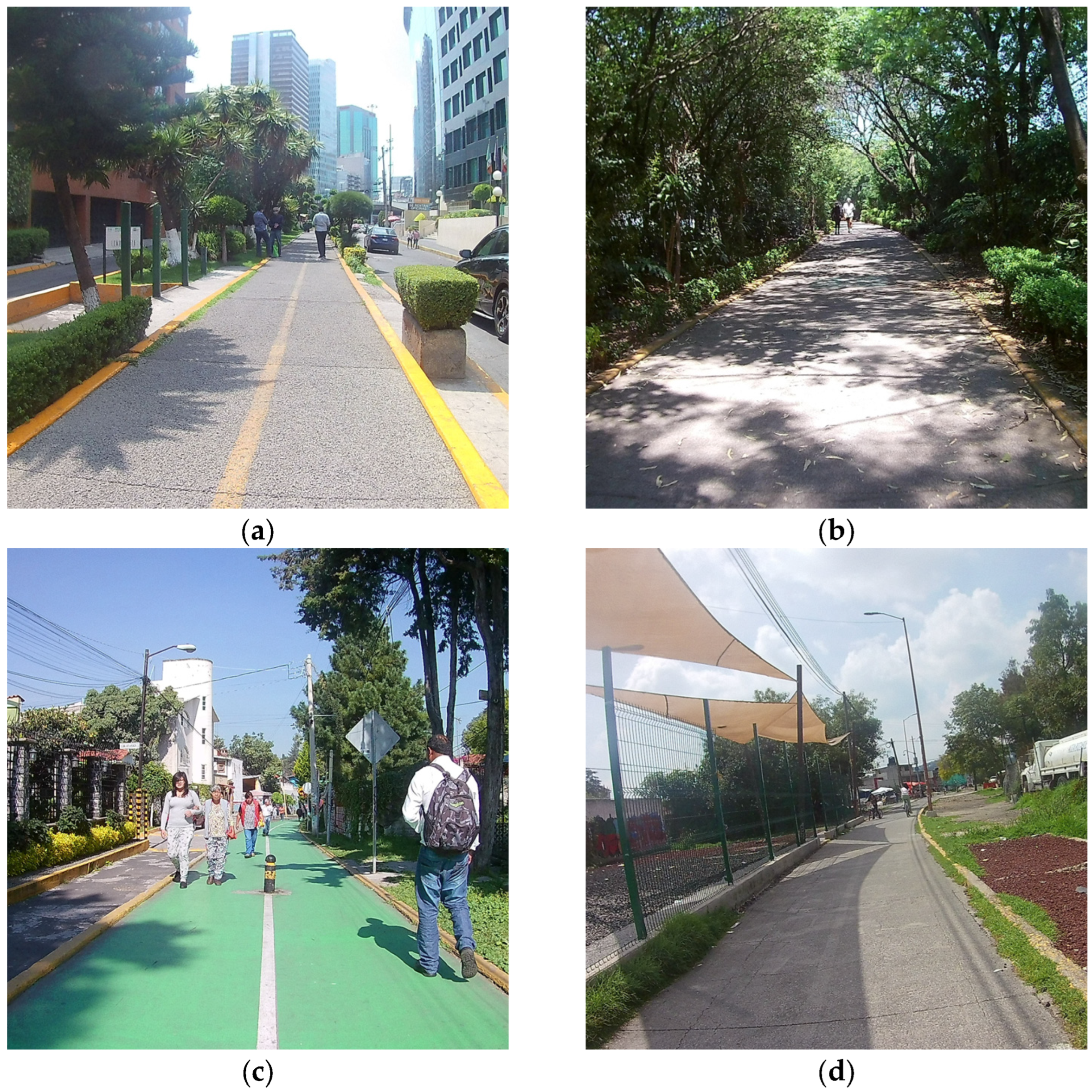
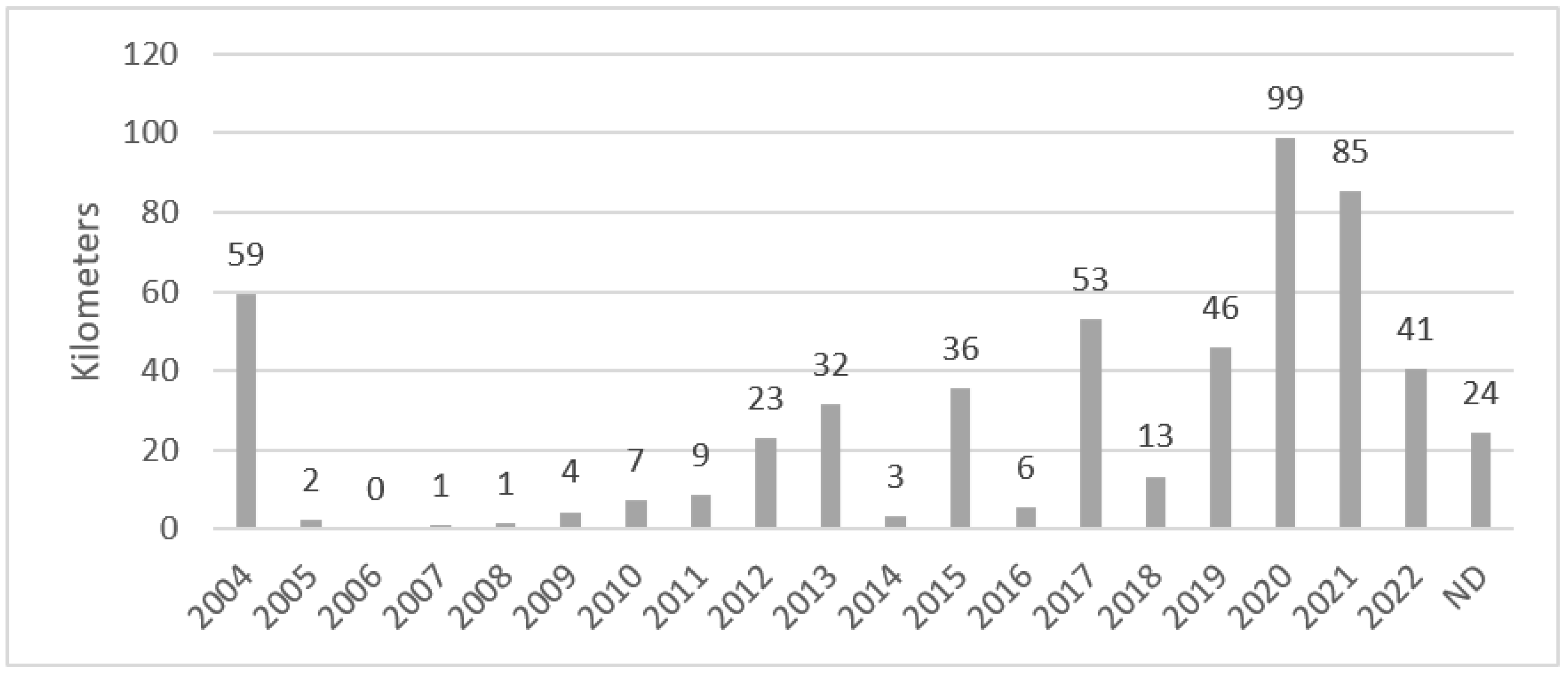
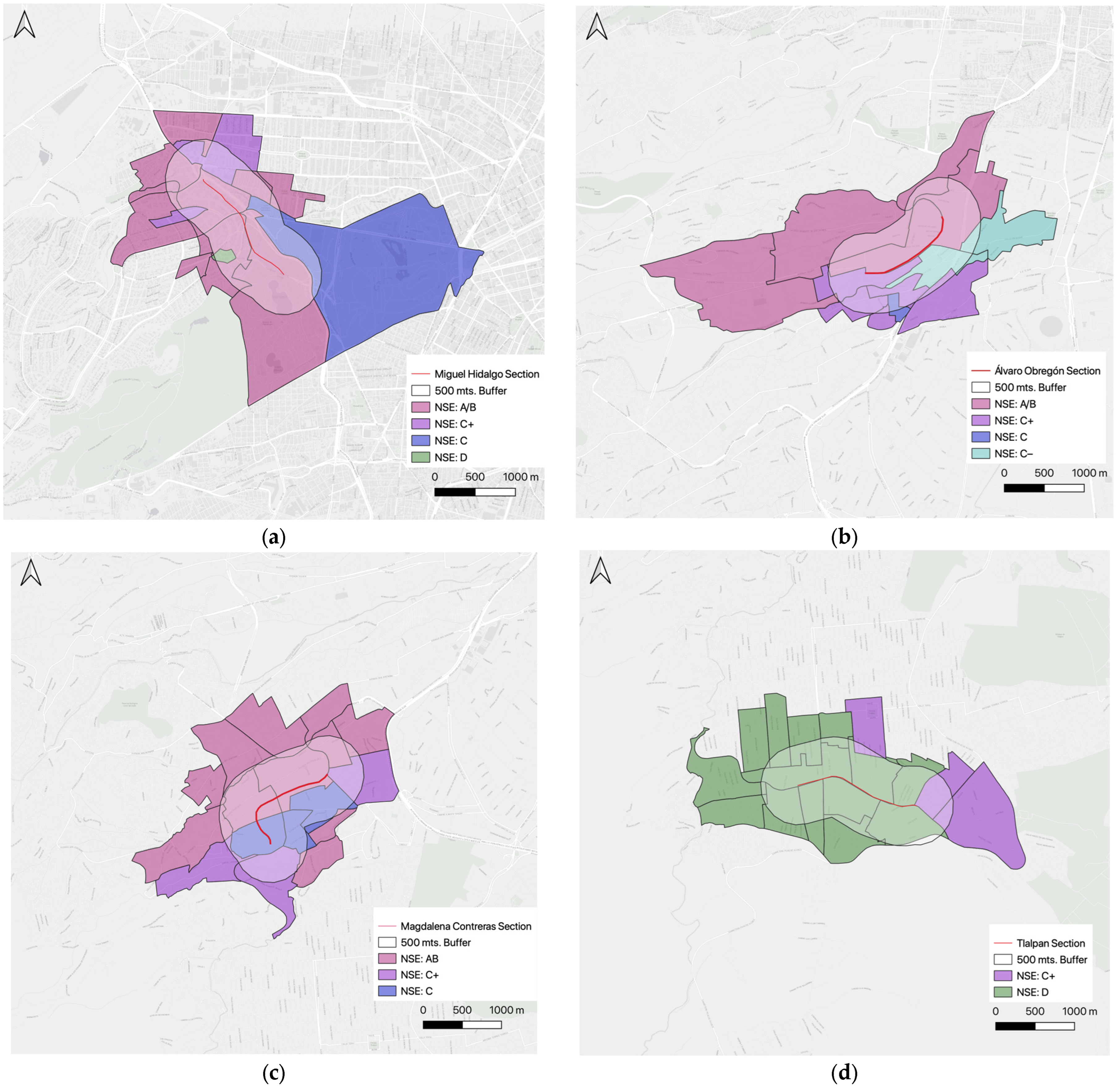
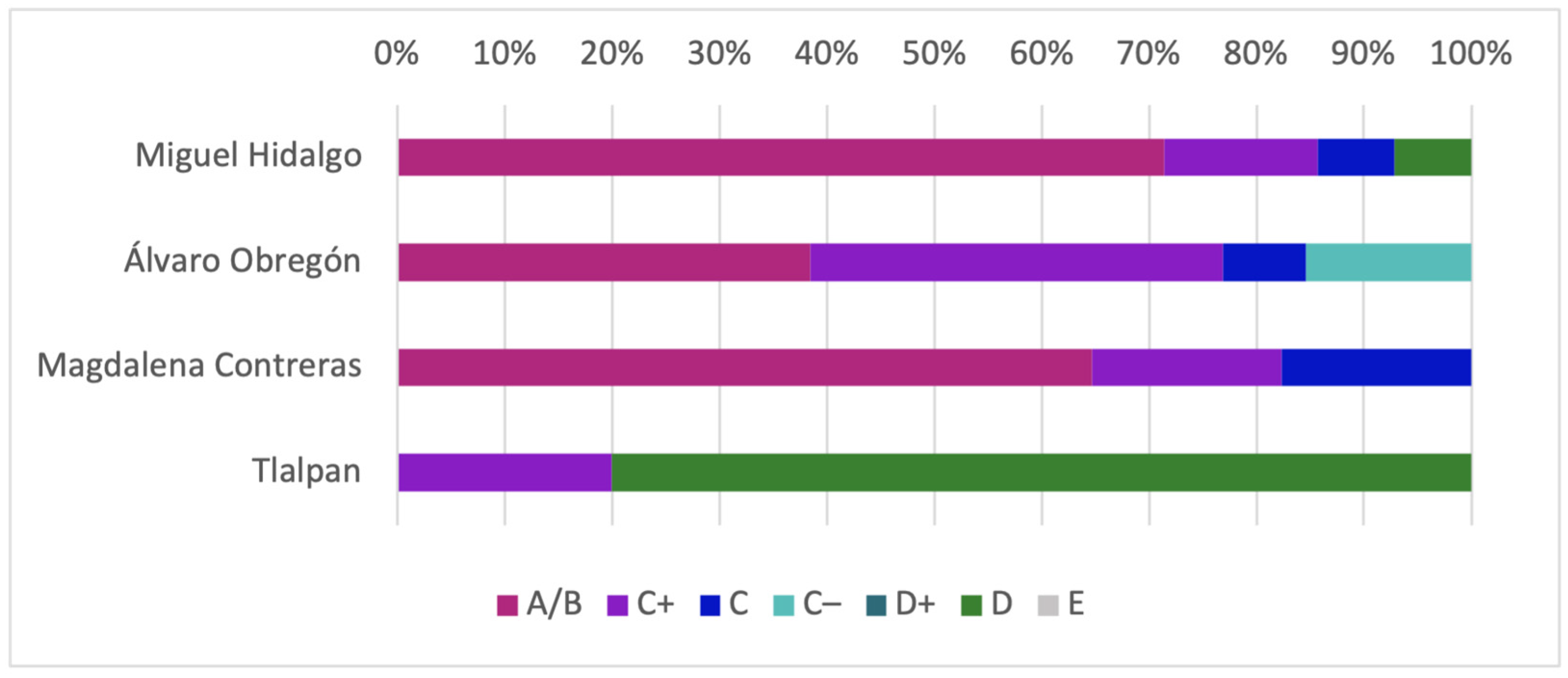
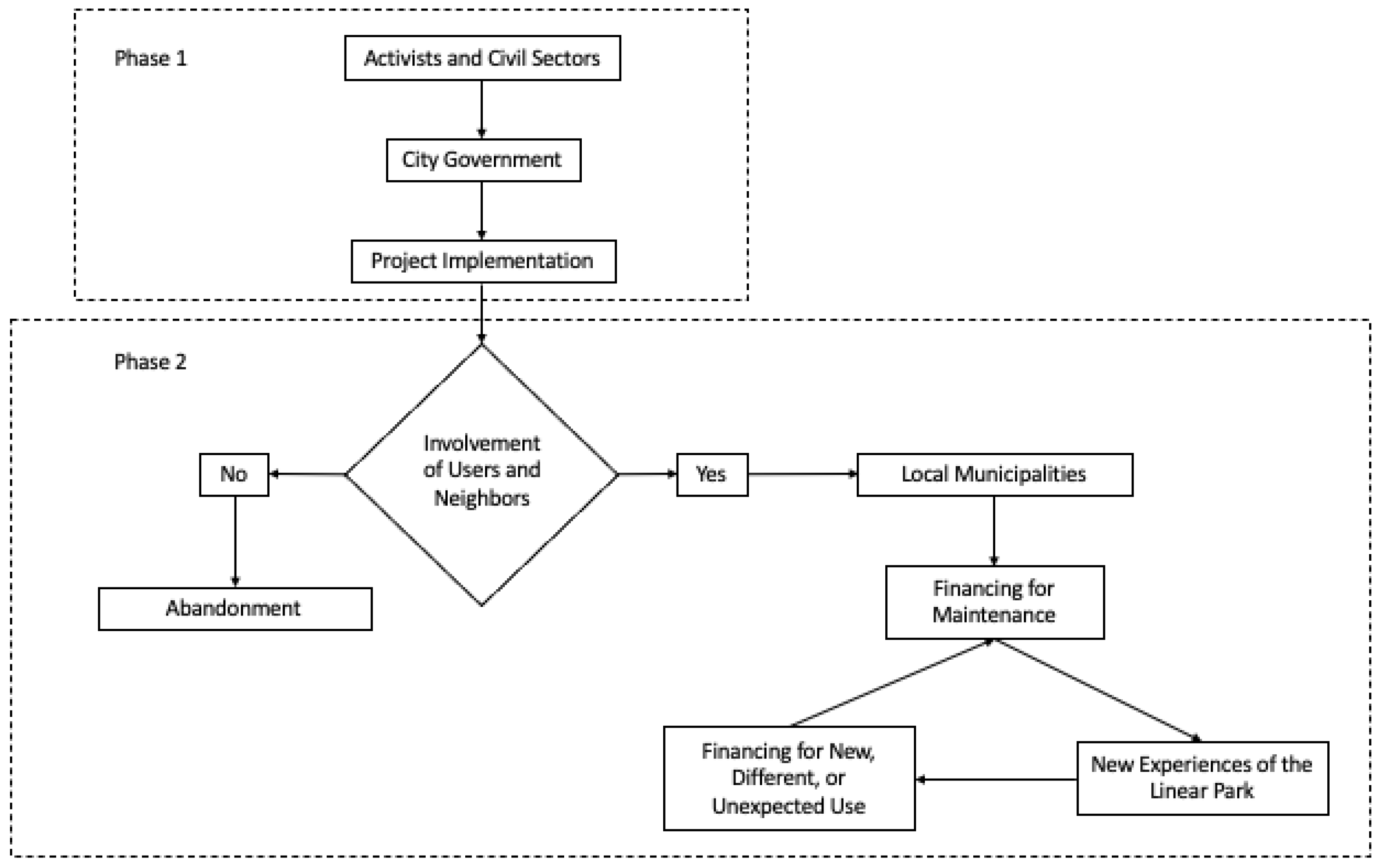
| Miguel Hidalgo | Álvaro Óbregón | Magdalena Contreras | Tlalpan | |||||||||||||
|---|---|---|---|---|---|---|---|---|---|---|---|---|---|---|---|---|
| NSE | N. of NSE | Area (km2) | Population | Density | N. of NSE | Area (km2) | Population | Density | N. of NSE | Area (km2) | Population | Density | N. of NSE | Area (km2) | Population | Density |
| A/B | 10 | 5.30 | 18,904 | 5033 | 5 | 3.07 | 25,757 | 7038 | 11 | 3.74 | 40,655 | 11,029 | ||||
| C+ | 2 | 0.49 | 1914 | 2741 | 5 | 2.34 | 20,087 | 9827 | 3 | 0.82 | 12,273 | 18,326 | 3 | 0.75 | 11,230 | 14,410 |
| C | 1 | 0.04 | 13 | 356 | 1 | 0.13 | 2569 | 19,377 | 3 | 0.82 | 9844 | 12,467 | ||||
| C− | 1 | 1.67 | 265 | 159 | 2 | 0.73 | 8053 | 12,118 | ||||||||
| D+ | ||||||||||||||||
| D | 12 | 4.60 | 77,726 | 17,064 | ||||||||||||
| E | ||||||||||||||||
| Miguel Hidalgo | Álvaro Obregón | La Magdalena Contreras | Tlalpan | |
|---|---|---|---|---|
| Adults | 2350 | 631 | 1197 | 1490 |
| Children | 13 | 75 | 160 | 197 |
| Male | 1308 | 435 | 624 | 797 |
| Female | 1055 | 271 | 733 | 890 |
| Total of Users | 2363 | 706 | 1357 | 1687 |
| Runners | 12 | 11 | 159 | 10 |
| Still | 37 | 67 | 4 | 169 |
| Pedestrian | 2117 | 480 | 735 | 1366 |
| With pets | 26 | 43 | 254 | 16 |
| Bicycling | 171 | 95 | 170 | 127 |
| Main Sector of Commons | Sub-Sector 1 | Sub-Sector 3 |
|---|---|---|
| Infrastructure commons | Transportation | |
| Budgets | ||
| Markets as commons | Exchange commons | |
| Global commons | Atmosphere | |
| Pollution | ||
| Public health | ||
| Infrastructure | ||
| Social Commons | ||
| Neighborhood commons | Homeless habitat | |
| Parks and greenery | ||
| Security | ||
| Sidewalks | ||
| Streets | ||
| Silence/Noise | ||
| Cultural commons | Non-profit organizations | |
| Public arts | ||
| Sports | ||
| Tourism | Landscapes | |
| Eco-tourism |
Disclaimer/Publisher’s Note: The statements, opinions and data contained in all publications are solely those of the individual author(s) and contributor(s) and not of MDPI and/or the editor(s). MDPI and/or the editor(s) disclaim responsibility for any injury to people or property resulting from any ideas, methods, instructions or products referred to in the content. |
© 2023 by the authors. Licensee MDPI, Basel, Switzerland. This article is an open access article distributed under the terms and conditions of the Creative Commons Attribution (CC BY) license (https://creativecommons.org/licenses/by/4.0/).
Share and Cite
Buratti, S.; Merino-Pérez, L. Linear Parks as Urban Commons—Considerations from Mexico City. Sustainability 2023, 15, 9542. https://doi.org/10.3390/su15129542
Buratti S, Merino-Pérez L. Linear Parks as Urban Commons—Considerations from Mexico City. Sustainability. 2023; 15(12):9542. https://doi.org/10.3390/su15129542
Chicago/Turabian StyleBuratti, Simone, and Leticia Merino-Pérez. 2023. "Linear Parks as Urban Commons—Considerations from Mexico City" Sustainability 15, no. 12: 9542. https://doi.org/10.3390/su15129542







